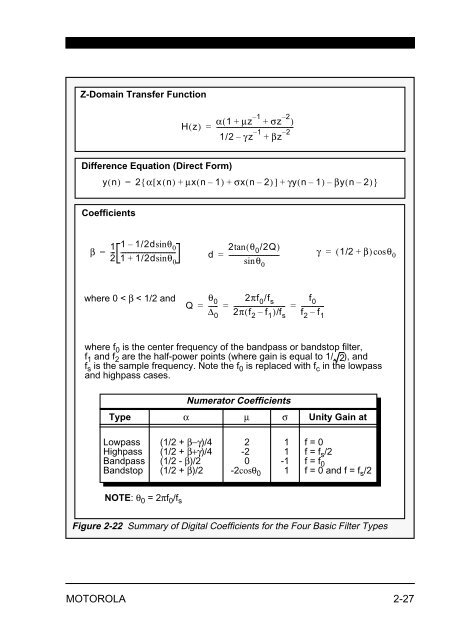Implementing IIR/FIR Filters
Implementing IIR/FIR Filters
Implementing IIR/FIR Filters
Create successful ePaper yourself
Turn your PDF publications into a flip-book with our unique Google optimized e-Paper software.
Z-Domain Transfer Function<br />
Hz ( )<br />
Difference Equation (Direct Form)<br />
Coefficients<br />
α 1 μz 1 –<br />
σz 2 –<br />
( + + )<br />
1/2 γz 1 –<br />
– βz 2 –<br />
= ------------------------------------------------<br />
+<br />
yn ( ) = 2{ α[ x(<br />
n)<br />
+ μxn ( – 1)<br />
+ σxn ( – 2)]<br />
+ γyn ( – 1)<br />
– βyn ( – 2)<br />
}<br />
1<br />
β --<br />
2<br />
1 1/2dsinθ –<br />
0<br />
2tan( θ<br />
= -----------------------------------<br />
0 /2Q)<br />
γ = ( 1/2 + β)<br />
cosθ<br />
1 + 1/2dsinθ d = --------------------------------<br />
0<br />
0<br />
sinθ0<br />
where 0 < β < 1/2 and θ0 2 π f 0 /fs f 0<br />
Q = ----- = -------------------------------- = --------------<br />
Δ0 2π( f2 – f1)/fs f 2 – f 1<br />
where f0 is the center frequency of the bandpass or bandstop filter,<br />
f1 and f2 are the half-power points (where gain is equal to 1/ 2),<br />
and<br />
fs is the sample frequency. Note the f0 is replaced with fc in the lowpass<br />
and highpass cases.<br />
Type α μ σ Unity Gain at<br />
Lowpass<br />
Highpass<br />
Bandpass<br />
Bandstop<br />
NOTE: θ 0 = 2πf 0 /f s<br />
Numerator Coefficients<br />
(1/2 + β−γ)/4<br />
(1/2 + β+γ)/4<br />
(1/2 - β)/2<br />
(1/2 + β)/2<br />
2<br />
-2 0<br />
-2cosθ 0<br />
Figure 2-22 Summary of Digital Coefficients for the Four Basic Filter Types<br />
MOTOROLA 2-27<br />
1<br />
1<br />
-1 1<br />
f = 0<br />
f = f s /2<br />
f = f 0<br />
f = 0 and f = f s/2
















